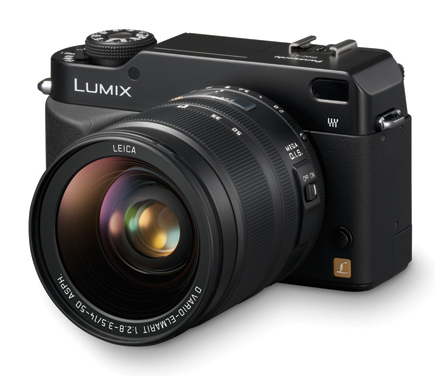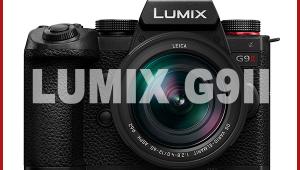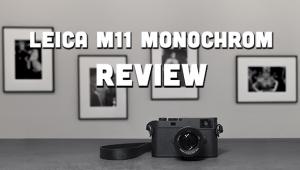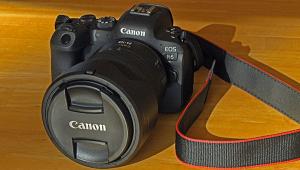Panasonic’s Lumix DMC-L1; High-Tech Digital SLR With Conventional Controls And Traditional Style
The first Panasonic D-SLR, the Lumix DMC-L1 is a product of an alliance with Olympus, since it employs, according to the company, some "jointly developed technologies and components." In fact, this camera shares many attributes with the Olympus EVOLT E-330, including the lens mount, Supersonic Wave sensor dust removal system, and Panasonic's Four Thirds format "Live MOS" sensor. This chip is said to provide the "outstanding image quality of a CCD and the low energy consumption of a CMOS sensor" with high sensitivity, a low-noise photodiode signal amplification circuit, simplified circuitry, and a large photo-sensing surface.
 |
Other shared aspects include the "porro" finder, nearly identical light metering, autofocus, and flash systems. More importantly perhaps, both cameras provide "Live View" that allows for true, continuous image preview on the LCD monitor still unique in D-SLRs. And yet, in spite of all the similarities, it's obvious at a glance that the DMC-L1 is an entirely different camera than the EVOLT E-330. Featuring very traditional styling and controls, and packaged with a premium-grade Leica D-series zoom, the Lumix model was intended to appeal to another type of photographer.
It's also worth noting some of the significant internal differences. For example, the Lumix camera employs a new Venus Engine III LSI that's exclusive to Panasonic. This processor controls luminance noise and chroma noise individually while low voltage (5v) processing is said to minimize digital noise. There are other differences, too, in feature set, speed, and performance as I discovered during extensive testing. There's no merit in dwelling on those in the text of this review but I have summarized the most noteworthy points in the accompanying sidebar below.
 |
|
|
Design And Construction
Resembling an oversized 35mm rangefinder camera, the Lumix DMC-L1 boasts a lightweight magnesium-alloy chassis. It's beautifully finished in satin black with a simulated rubber coating on and around the handgrip. This is a flattop camera without the typical penta-prism hump. That's because it employs an optical porro finder with three mirrors plus a reflex mirror that swings sideways (not up/down). In keeping with the "classic" styling, the camera features some "retro" controls instead of the more typical buttons and dials found on other D-SLRs. These include a traditional shutter speed dial, two mechanical levers, plus a mechanical aperture ring on the Leica D lens that's part of the camera kit.
Press the Open button on the back and a unique mechanism becomes apparent: a pop-up flash that can be set at either of two angles thanks to an articulated mechanism. The first allows for bouncing light from a ceiling for softer illumination while the second is used for direct flash, with the head raised high above the lens to minimize redeye. This "dual-angle" function works exactly as expected and also makes the Lumix camera appear entirely different than any other D-SLR.
In basic operation, the Lumix DMC-L1 is similar to a 35mm SLR camera of the 1980s. Program mode is selected by locking the aperture ring and shutter speed dial to A. For Aperture Priority mode, simply rotate the aperture ring to any f/stop. To switch to Shutter Priority, lock the ring to A and rotate the shutter speed dial to the desired position. For fully manual operation, simply use both of those old-style controls; guidance on exposure is provided by an LED scale in the viewfinder.
 |
|
 |
|
|
In other respects, this is definitely an ultrahigh-tech model with electronic buttons, dials, and menu screens. However, the DMC-L1 has more analog controls than many other cameras to minimize the need for hunting through the multi-page electronic menu. They're all well marked and most are logically/conveniently located. However, the shutter release button is located in the center of the shutter speed dial, a bit far back from the front of the camera for maximum comfort. Surprisingly, there's no specific button for ambient light exposure compensation; that feature is available via the input dial, but only when specifically selected using a custom function.
The lens is worth considering, too, because the DMC-L1 is sold only with the Leica D VARIO-ELMARIT 14-50mm f/2.8-3.5 ASPH zoom (28-100mm equivalent) with two glass-molded dual-sided aspherical elements and extensive multilayered coating. That combination was intended to control vignetting, aberrations, linear distortion, and flare. Manufactured by Panasonic to Leica's "rigorous quality standards," it's large because of the wide maximum apertures and heavy because of the very rugged construction and the built-in MEGA OIS (Optical Image Stabilization) stabilizer and a dedicated processing engine. In handheld shooting at a 100mm equivalent focal length with OIS, I was often able to get sharp photos at a 1¼20 sec shutter speed instead of the 1/100 sec required with conventional lenses.
 |
|
|
Evaluation: This is a solid camera with a prestigious look and feel. When using the analog controls, operation was certainly straightforward. My only complaint was that certain levers--for metering pattern, Drive mode, and Focus mode selection--are not adequately stiff; they're easy to accidentally nudge off the desired setting, producing unpredictable results. Note, too, that the viewfinder is slightly small and the view is a bit darker than average when compared to cameras with the APS format sensors.
First time digital camera buyers will find some of the numerous menu items to be confusing, but that's true with every competing model as well. It's worth studying the Owners Manual because the menu contains a wide range of functions for controlling virtually every aspect of a digital image. On the other hand, anyone who has used only a high-tech camera (with electronic buttons and dials) may find the old-style operating sequences to be "strange"; however, that type of shooter is not likely to be a typical buyer of this Lumix D-SLR.
Instead of five or more focus detection points, the DMC-L1 is limited to three, so it's not ideal for quick shooting with small, off-center subjects. The ultrasonic dust removal system is a real bonus; during a month of testing, not one of my images exhibits even a single visible dust spot. In long-term use, I would personally miss only one feature: the ability to quickly delete an image in instant review, without the need to switch to the full Playback mode.
 |
|
|
The Leica D zoom lens adds substantially to the price of the Lumix kit but the price is warranted. This luxurious lens--reminiscent of a Leica R-series product--is perfectly finished; the mechanisms are remarkably smooth. It's extremely well controlled for flare, all types of linear distortion, and chromatic aberration. Not one of my images exhibited purple fringing even in the extreme contrast of a backlit scene. Optimal edge-to-edge quality was provided at every f/stop from f/4-f/16. Naturally, the Lumix DMC-L1 is compatible with Sigma and Olympus Zuiko Digital lenses with the Four Thirds mount. Even so, buyers of this upscale camera kit will probably wait anxiously for Panasonic to start introducing additional lenses. The company has already announced a gorgeous Leica D Summilux 25mm f/1.4 ASPH (50mm equivalent) model with MEGA OIS stabilizer and we expect to see other Leica D lenses in the future.
- Log in or register to post comments

















































